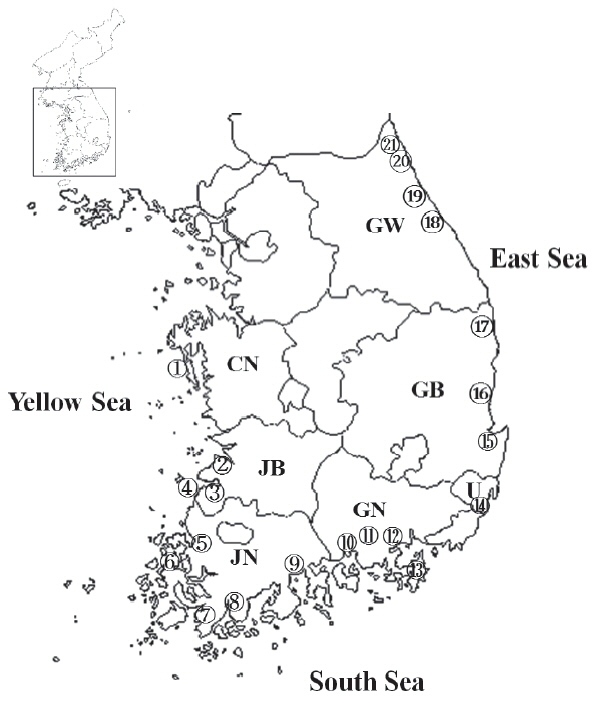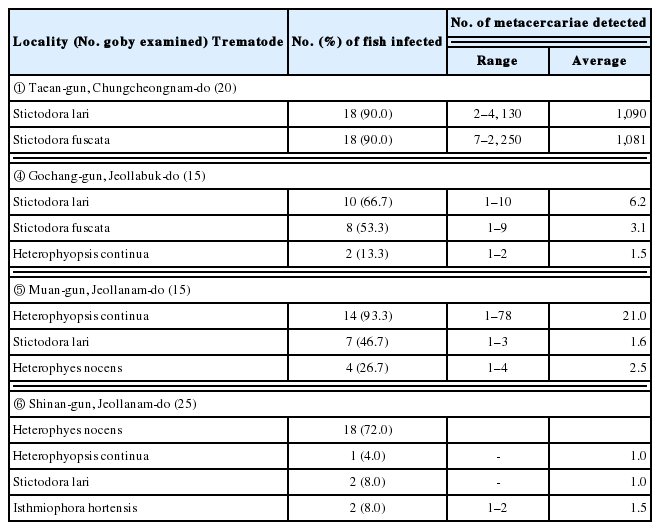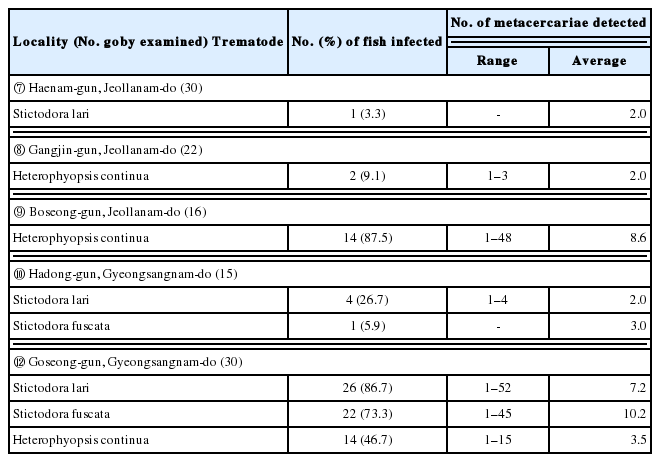Infections with Zoonotic Trematode Metacercariae in Yellowfin Goby, Acanthogobius flavimanus, from Coastal Areas of Republic of Korea
Article information
Abstract
To investigate the infection status of zoonotic trematode metacercariae in yellowfin goby, Acanthogobius flavimanus, from coastal areas of the Republic of Korea (Korea), we examined total 344 gobies from 21 localities with an artificial digestion method from 2013 to 2017. The metacercariae of Stictodora lari were most frequently detected in 45.3% goby from 7 localities, i.e., Taean-gun (Chungcheongnam-do), Gochang-gun (Jeollabuk-do), Muan-gun, Shinan-gun, Haenam-gun (Jeollanam-do), Hadong-gun and Goseong-gun (Gyeongsangnam-do). Their infection rates were 90.0%, 66.7%, 46.7%, 8.0%, 3.3%, 26.7%, and 86.7% and intensities were 1,090, 6.2, 1.6 1.0, 2.0, 2.0, and 7.2 metacercariae per fish infected respectively. Heterophyopsis continua metacercariae were found in 38.2% goby from 6 localities, i.e., Gochang-gun, Muan-gun, Shinan-gun, Gangjin-gun, Boseong-gun (Jeollanam-do) and Goseong-gun, and their intensities were relatively low, 1–21 metacercariae. Stictodora fuscata metacercariae were detected in 61.3% goby from 4 localities, i.e., Taean-gun, Gochang-gun, Hadong-gun and Goseong-gun. Their infection rates were 90.0%, 53.3%, 5.9%, and 73.3% and intensities were 1,081, 3.1, 3.0, and 10.2 metacercariae per fish infected respectively. Heterophyes nocens metacercariae were found in 55.0% goby from Muan-gun and Shinan-gun. Total 3 metacercariae of Isthmiophora hortensis were detected in 2 (8.0%) gobies from Shinan-gun. Total 15 metacercariae of Centrocestus armatus were detected in 5 gobies (33.3%) from Gyeongpo-ho (ho means lake) in Gangneung-si, Gangwon-do. The present study suggests that yellowfin goby, A. flavimanus, acts as the infection sources of zoonotic intestinal flukes in western and southern coastal areas than in eastern coastal areas of Korea.
INTRODUCTION
Fishborne zoonotic trematodes (FZT) affect the health of peoples in the endemic areas of the world. A lot of trematode species are known to be participated in human infections. Among them, members in family Heterophyidae are very small parasites and clinically important in both aspects of intestinal and extraintestinal cases. More than 30 species in 13 genera have been known to infect human beings all over the world [1–3]. In the Republic of Korea (Korea), 11 species in 8 genera have been reported as human-infecting species of heterophyid flukes. Among these, 7 species, Heterophyes nocens, Heterophyopsis continua, Pygidiopsis summa, Stellantchasmus falcatus, Stictodora fuscata, Stictodora lari, and Acanthotrema felis, are infected by the consumption of the raw flesh of brackish water fish [2,4–11]. Lots of residents in the southern and western coastal areas of Korea are infected with these intestinal flukes [12–18]. As the second intermediate host (and/or the source of human infection) of heterophyid flukes, several species of brackish water fish, i.e., Lateolabrax japonicus, Konosirus punctatus, Mugil cephalus, Chelon haematocheilus, Acanthogobius flavimanus, Boleophthalmus pectinirostris, and Scartelaos sp., have been reported in Korea [4–11,19–26].
The studies on the source of human infection for heterophyid flukes were mainly performed in the endemic areas in the western and southern coastal areas of Korea. Most of them were carried out in limited areas and examined small number of fish hosts [6,19–25]. Especially, Seo et al. [19] investigated mullet and goby from 14 and 5 localities in the western and southern coastal areas of Korea to know the geographical distribution of Pygidiopsis and Heterophyes metacercariae. Seo et al. [20] also examined mullet, perch and goby from 5, 1, and 3 southwestern coastal areas to survey the infection sources of H. continua. Sohn et al. [21] performed an epidemiological survey to know the infection status of heterophyid metacercariae in 4 species of brackish water fish, i.e., shad, perch, mullet and goby, from a local market in Haenam-gun (gun=county), Jeollanam-do (do=province). Kim et al. [23] investigated the heterophyid metacercariae infections in brackish water fishes, i.e., perch, shad, mullet, redlip mullet, and goby, from Jinjuman (man means Bay), Gyeongsangnam-do, Korea. Guk et al. [24] surveyed the infection status of mullet and goby with metacercariae of Heterophyes nocens and Pygidiopsis summa. Sohn et al. [25] performed an epidemiological survey to know the infection status of FZT metacercariae in yellowfin goby collected in Shinan-gun and Muan-gun, Jeollanam-do. Recently, Cho et al. [26] surveyed the infection status of trematode metacercariae in estuarine fishes including yellowfin goby from Muan-gun, Jeollanam-do. Sohn et al. [27] investigated the infection status of P. summa metacercariae in mullets from coastal areas of Korea. However, most of studies were performed in limited areas and the number of fish was not enough to evaluate the metacercarial endemicity in each surveyed area. Therefore, we examined goby broadly collected from 21 coastal areas in 3 Korean seas, Yellow Sea, South Sea and East Sea, to know the infection status of zoonotic trematode metacercariae (ZTM).
MATERIALS AND METHODS
Collection sites of yellowfin goby (Number of goby examined)
① Taean-gun (20), Chungcheongnam-do: Byeongsul-man in Ahnmyeon-eup (eup=town) (latitude: 36.478867; longitude: 126.342750); ② Buan-gun (15), Jeollabuk-do: Dongjeon-ri (ri=village) in Dongjin-myeon (myeon=township) (35.758721; 126.776704); ③ Gochang-gun (11), Jeollabuk-do: Eupnae-ri in Gochang-eup (35.433979; 126.702451); ④ Gochang-gun (15), Jeollabuk-do: Dongho-ri in Haeri-myeon (35.509479; 126.497485); ⑤ Muan-gun (15), Jeollanam-do: Haeje-myeon (35.092247; 126.304052); ⑥ Shinan-gun (25), Jeollanam-do: Aphae-eup (34.841932; 126.363447); ⑦ Haenam-gun (30), Jeollanam-do: Hwangsan-myeon (34.596476; 126.460790); ⑧ Gangjin-gun (22), Jeollanam-do: Daegu-myeon (34.500880; 126.792037); ⑨ Boseong-gun (16), Jeollanam-do: Beolgyo-eup (34.830308; 127.370214); ⑩ Hadong-gun (15), Gyeongsangnam-do: Jingyomyeon (35.009910; 127.918501); ⑪ Sacheon-si (25), Gyeongsangnam-do: Gonyang-cheon (cheon means stream) in Gonyang-myeon (35.049422; 127.975090); ⑫ Goseong-gun (30), Gyeongsangnam-do: Baedun-ri in Hoehwa-myeon (35.048684; 128.372615); ⑬ Geoje-si (10), Gyeongsangnam-do: Dundeokcheon in Dundeok-myeon (34.838177; 128.508674) ⑭ Ulsan Metropolitan City (1): Taehwa-gang (gang means river) in Junggu (35.547438; 129.297372); ⑮ Pohang-si (15), Gyeongsangbukdo: Hyeongsan-gang in Yeonil-eup (36.003818; 129.332359); ⑯ Yeongdeok-gun (2), Gyeongsangbuk-do: Osip-cheon in Ganggumyeon (36.379421; 129.376851); ⑰ Uljin-gun (1), Gyeongsangbuk-do: Wangpi-cheon in Uljin-eup (36.965826; 129.394991); ⑱ Gangneung-si (26), Gangwon-do: Gyeongpo-ho (ho means lake) in Woonjeong-dong (37.797481; 128.911507); ⑲ Yangyanggun (16), Gangwon-do: Mae-ho in Hyeonnam-myeon (37.949 674; 128.774899); ⑳ Goseong-gun (11), Gangwon-do: Songjiho in Jukwang-myeon (38.335426; 128.51339); ㉑ Goseonggun (23), Gangwon-do: Hwajinpo-ho in Geojin-eup (38.466 792; 128.442357) (Fig. 1).

Surveyed areas in ①Taean-gun in Chungcheongnam-do (CN); ②Buan-gun, ③Gochang-gun (Eupnae-ri in Gochang-eup) and ④Gochang-gun (Dongho-ri in Haeri-myeon) in Jeollabuk-do (JB); ⑤Muan-gun, ⑥Shinan-gun, ⑦Haenam-gun, ⑧Gangjin-gun and ⑨Boseong-gun in Jeollanam-do (JN); ⑩Hadong-gun, ⑪Sacheon-si, ⑫Goseong-gun and ⑬Geoje-si in Gyeongsangnam-do (GN); ⑭Ulsan Metropolitan City (U), ⑮Pohang-si, ⑯Yeongdeokgun, and ⑰Uljin-gun in Gyeongsangbuk-do (GB); ⑱Gangneungsi, ⑲Yangyang-gun, ⑳Goseong-gun (Songjiho in Jukwang-myeon), and ㉑Goseong-gun (Hwajinpoho in Geojin-eup) in Gangwon-do (GW).
Examination of fish
Total 344 gobies were collected in the above 21 coastal areas for 5 years (2013: ①–⑥; 2014: ⑦–⑬, ⑱, ㉑; 2015: ⑭–⑰, ⑳; 2017: ⑱–㉑). All collected goby were transferred to our laboratory (in Department of Parasitology and Tropical Medicine, Gyeongsang National University College of Medicine, Jinju, Korea) with ice, and examined by the artificial digestion method. Each fish was finely ground with a mortar or grinder, the ground fish meat was mixed well with artificial gastric juice, and the mixture was incubated at 36°C for 2 hr. The digested material was filtered with 1×1 mm of mesh and washed with 0.85% saline untill the supernatant is clear. Trematode metacercariae were collected from sediments under a stereomicroscope and categorized according to the size and morphological characteristics. Infection rates (%) and intensities (No. of ZTM per fish infected) were then calculated.
RESULTS
Infection status of ZTM in yellowfin goby from western coastal areas No metacercariae were detected in goby from ② Buan-gun and ③ Gochang-gun. In goby from ① Taean-gun, 2 species of Stictodora, S. lari and S. fuscata, metacercariae were commonly detected in 18 (90.0%) fish, and their intensities were 1,090 and 1,081 per fish infected. Total 3 species of heterophyid, i.e., S. lari, S. fuscata, and H. continua, metacercariae were found in 66.7%, 53.3%, and 13.3% goby from ④ Gochang-gun, and their intensities were 6.2, 3.1, and 1.5 per fish infected respectively. In goby from ⑤ Muan-gun, 3 species of heterophyid, i.e., H. continua, S. lari, and H. nocens, metacercariae were found in 93.3%, 46.7%, and 26.7% fish, and their intensities were 21.0, 1.6, and 2.5 per fish infected respectively. Total 4 species, i.e., H. nocens, H. continua, S. lari, and Isthmiophora hortensis, of ZTM were found in 72.0%, 4.0%, 8.0%, and 8.0% goby from ⑥ Shinan-gun, and their intensities were 21.1, 1.0, 1.0, and 1.5 per fish infected respectively. Infection status of ZTM in goby from western coastal areas is detailedly designated in Table 1.

Infection status of trematode metacercariae in yellowfin goby, Acanthogobius flavimanus, from western coastal areas of Korea
Infection status of ZTM in yellowfin goby from southern coastal areas
No metacercariae were detected in goby from ⑪ Sacheon-si and ⑬ Geoje-si. Total 2 metacercariae of S. lari were found in only one goby (3.3%) from ⑦ Haenam-gun. In goby from ⑧ Gangjin-gun, and ⑨ Boseong-gun, only H. continua metacercariae were detected in 9.1% and 87.5% fish, and their intensities were 2.0 and 8.6 per fish infected each. Two species of Stictodora, S. lari, and S. fuscata, metacercariae were found in 26.7% and 5.9% goby from ⑩ Hadong-gun, their intensities were 2.0 and 3.0 per fish infected. In goby from ⑫ Goseonggun, 3 species of heterophyid, i.e., S. lari, S. fuscata, and H. continua, metacercariae were detected in 86.7%, 73.3%, and 46.7% fish, and their intensities were 7.2, 10.2, and 3.5 per fish infected respectively. Infection status of ZTM in goby from southern coastal areas is shown in Table 2.
Infection status of ZTM in yellowfin goby from eastern coastal areas
No ZTM were detected in all goby from eastern coastal areas except those from ⑱ Gyeongpo-ho in Gangneung-si, Gangwon-do. Total 15 metacercariae of Centrocestus armatus were detected in 5 gobies (33.3%) from ⑱ Gyeongpo-ho.
DISCUSSION
By the present study, It was confirmed that ZTM are mainly prevalent in goby from the western and southern coastal areas of Korea. No ZTM were detected in total 95 gobies from the eastern coastal areas except for 5 ones from Gyeongpo-ho in Gangneung-si, Gangwon-do. Total 4 species of heterophyid flukes, i.e., H. nocens, H. continua, S. lari, and S. fuscata, and 1 species of echinostomatid fluke, I. hortensis, metacercariae were detected in the goby from the western coastal areas. Among these, H. nocens metacercariae were prevalent in the goby from Shinan-gun, H. continua metacercariae were relatively prevalent in the goby from Muan-gun, Jeollanam-do, and S. lari, and S. fuscata metacercariae were highly prevalent in the goby from Taean-gun, Chungcheongnam-do. In the goby from the southern coastal areas, 3 species of heterophyid flukes, i.e., H. continua, S. lari, and S. fuscata, metacercariae were detected. However, their endemicities were not so high. In the eastern coastal areas, only Centrocestus armatus metacercariae were found in 5 gobies from Gyeongpo-ho in Gangneung-si, Gangwon-do. Therefore, we are able to know that ZTM are more prevalent in the goby from the western coastal areas than from southern coastal areas, and they are very rarely infected in the goby from the eastern coastal areas.
The yellowfin goby, A. flavimanus, is known to be the suitable fish host of 6 species of heterophyid flukes, i.e., H. nocens, H. continua, P. summa, S. fuscata, S. lari, and A. felis, and 1 species of echinostome, I. hortensis, in Korea [8–10,20–25]. In the present study, 5 species, i.e., H. nocens, H. continua, S. lari, S. fuscata, and I. hortensis, of ZTM were detected, and their infection rates and intensities were more or less different by the species of ZTM and surveyed areas. Cho et al. [26] detected 3 species, i.e., H. continua, S. lari, and A. felis, of ZTM in the goby from Muan-gun, Jeollanam-do. Their each prevalences and intensities were relatively high. Sohn et al. [25] detected more than 5 species, i.e., H. nocens, H. continua, P. summa, Stictodora spp., and I. hortensis, of ZTM in the goby from Shinan-gun and Muan-gun, Jeollanam-do. Their each prevalences and intensities were much different from those of the same regions in this study. Sohn et al. [21] found 3 species, i.e., H. nocens, H. continua, and S. fuscata, of ZTM in the goby from Haenam-gun in Jeollanam-do. In this study, only 2 S. lari metacercariae were detected in only 1 out of 30 gobies from Haenam-gun. Kim et al. [23] detected more than 2 species, Stictodora spp. and H. continua, of ZTM in the goby from Jinju-man. However, we found no ZTM in 25 gobies from Gonyang-cheon in Sacheonsi, Gyeongsangnam-do.
A species of heterophyid fluke, H. nocens, is known to be the prevalent species in the residents of western and southern coastal areas, i.e., Okgu-gun and Buan-gun in Jeollabuk-do, Muan-gun, Shinan-gun, Gangjin-gun, Goheung-gun, Haenamgun and Yeongam-gun in Jeollanam-do, Namhae-gun, Geojesi and Sacheon-si in Gyeongsangnam-do [12–16,18]. The yellowfin goby, A. flavimanus, act as one of the infection sources of this fluke in these endemic areas. Sohn et al. [25] reported 6.7% and 100% prevalences and 2 and 153 average intensities of H. nocens metacercariae in goby from Muan-gun and Shinan-gun, Jeollanam-do. Guk et al. [24] reported 20.0% and 40.0% prevalences and each 2 average metacercarial intensities in goby from Muan-gun in Jeollanam-do and Seocheon-gun in Chungcheongnam-do. Sohn et al. [21] also reported 10% prevalence and 32 average intensity of H. nocens metacercariae in goby from Haenam-gun in Jeollanam-do. In the present study, H. nocens metacercariae were detected in the goby from Muan-gun and Shinan-gun in Jeollanam-do only, their prevalences were 26.7% and 72.0% and intensities were 2.5 and 21.1 per fish infected. According to the results in previous and present studies, H. nocens metacercariae are most prevalent in the goby from Shinan-gun in Jeollanam-do, Korea.
Human infection cases of H. continua have been sporadically reported in the western and southern coastal areas, i.e., Buan-gun in Jeollabuk-do, Shinan-gun, Muan-gun, Gangjingun, Haenam-gun and Yeongam-gun in Jeollanam-do, Sacheon-si in Gyeongsangnam-do, of Korea [12,14,16,20,28]. Variety of fish species, i.e., L. japonicus, A. flavimanus, C. punctatus, M. cephalus, Conger myriaster, Plecoglossus altivelis, B. pectinirostris, and Scartelaos sp. were reported as the second intermediate hosts of this heterophyid fluke in Korea [4,11,20,21, 25,26,29]. Cho et al. [26] detected 45.8 H. continua metacercariae per fish infected in 27 (79.4%) goby from Muan-gun in Jeollanam-do. Sohn et al. [25] found 23.3 and 19.9 H. continua metacercariae per fish infected in each 15 (100%) goby from Muan-gun and Shinan-gun in Jeollanam-do. Kim et al. [23] found total 25 H. continua metacercariae in 9 (25.7%) out of 35 gobies from Jinju-man in Gyeongsangnam-do. Sohn et al. [21] also detected total 96 H. continua metacercariae in 3 (10%) out of 30 gobies from Haenam-gun in Jeollanam-do. In the present study, H. continua metacercariae were detected in goby from Gochang-gun in Jeollabuk-do, Muan-gun, Shinan-gun, Ganjin-gun and Boseong-gun in Jeollanam-do, and Goseong-gun in Gyeongsangnam-do, their prevalences were 4.0–93.3% (38.2% in average) and intensities were 1.0–21.0 (10 in average) per fish infected. Based on the results in previous and present studies, we can know that H. continua metacercariae are more or less prevalent in goby from Muan-gun in Jeollanam-do, but their endemicities were relatively low in the goby from other areas in Korea.
In the present study, S. lari metacercariae were found in goby from 7 surveyed areas, i.e., Taean-gun in Chungcheongnam-do, Gochang-gun in Jeollabuk-do, Muan-gun, Shinangun and Haenam-gun in Jeollanam-do, Hadong-gun and Goseong-gun in Gyeongsangnam-do. Their endemicities were not so high except for that in Taean-gun, Chungcheongnamdo. On the other hand, human infections with this fluke were reported in residents of 4 southwestern coastal villages in Gangjin-gun, Shinan-gun and Muan-gun in Jeollanam-do and Sacheon-si in Gyeongsangnam-do, Korea [2,16,18]. Metacercarial infections in goby were also reported in the southwestern coasts, i.e., Muan-gun in Jeollanam-do and Sacheon-si in Gyeongsangnam-do [8,26]. The metacercariae of S. fuscata were detected in the goby from 4 surveyed areas, Taean-gun in Chungcheongnam-do, Gochang-gun in Jeollabuk-do, Hadong-gun and Goseong-gun in Gyeongsangnam-do, in this study. Their endemicities were relatively low except for that in Taean-gun, Chungcheongnam-do. Human infections with this fluke were sporadically reported in peoples residing in the southwestern coastal areas of Korea [2,17,12–14,18]. Four species of brackish water fish, i.e., A. flavimanus, B. pectinirostris, M. cephalus, and C. haematocheilus, were known to be the second intermediate hosts in Korea [11,21,26]. Sohn et al. [21] detected total 9 S. fuscata metacercariae in 3 (10%) gobies from Haenam-gun, Jeollanam-do.
Sohn et al. [25], previously reported that the yellowfin goby, A. flavimanus, is a second intermediate host for I. hortensis in Korea. They detected total 8 I. hortensis metacercariae in 2 out of 14 gobies from Jido-myeon in Shinan-gun, Jeollanam-do. We also found total 3 I. hortensis metacercariae in 2 out of 25 gobies from Shinan-gun in Jeollanam-do. In the present study, it is first confirmed that the yellowfin goby, A. flavimanus, acts as the second intermediate host of C. armatus in Korea. Total 15 C. armatus metacercariae were detected in 5 (33.3%) gobies from Gyeongpo-ho in Gangneung-si, Gangwon-do. Conclusively the present study suggests that those who consume raw goby from western and southern coastal areas of Korea are at high risk of getting infected with heterophyid flukes.
ACKNOWLEDGMENTS
This study was supported by an Anti-Communicable Diseases Control Program, 2013 (Studies on the biological resources of human infecting trematodes and their larval infections in intermediate hosts), 2014 (Investigation of fish-borne parasites and acquisition of their biological resources in the southern regions of Korea) and 2015 (Investigation of fishborne parasites and acquisition of their biological resources in the eastern regions of Korea) of National Research Institute of Health (NRIH), Korea Centers for Disease Control and Prevention (KCDCP). We thank Jung-A Kim and Hee-Ju Kim, Department of Parasitology and Tropical Medicine, Gyeongsang National University College of Medicine, Jinju, Korea, for their help in fish examinations.
Notes
CONFLICT OF INTEREST
The authors have no conflicts of interest concerning the work reported in this paper.
